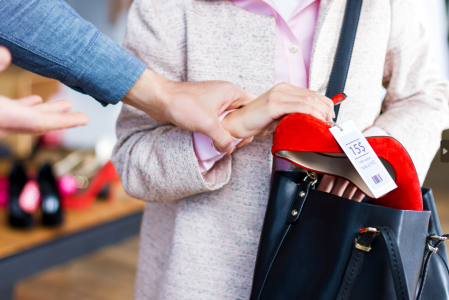‘Snatch and grab’, ‘swarming’ crimes hound South Australian stores
With prices for staples rising and living expenses continually increasing, people feel more financial pressure than ever.
This is why, unfortunately, shoplifting incidents in South Australia are on the rise. Small independent supermarkets, bottle shops, service stations and single-worker retailers are targeted more frequently by those seeking to steal items.
It's known as 'snatch and grab' and involves offenders taking items–such as groceries, alcohol and other household goods–and quickly leaving the premises.
Simon–whose name has been changed for privacy–who runs a supermarket in regional South Australia, says it's a daily occurrence and only getting worse.
Simon mentioned the common items targeted by thieves: ‘Sometimes it's high-value items, but often it's just basic household goods.’
'We had a patch about eight months ago, where it was happening every day, usually by the same offenders,' he added.
Simon and his brother have had to spend $15,000 on around 60 security cameras to monitor the store and have even installed a panic button so staff can get help if a theft occurs.
However, Simon claims that even though the store can provide high-resolution footage, the justice system doesn't take it seriously.
The cost of prosecuting suspected shoplifters is expensive, and even though Simon knows the faces of the offenders and has even put a colour photo up in the back of the shop, the offenders still come back a few days later.
It's a similar story for Sam Jain, who manages a supermarket in a busy area of Mount Gambier. He says that people of all ages are taking items from the shelves and leaving without paying for them.
‘People are just coming in every other day, all ages–even young kids–and stuffing items into their pants or jackets and just walking out,’ he said.
He added that some thieves are brazen and just ‘come in and just eat the products in the store’.
Sam tried to search bags or clothing of customers for stolen goods, but his efforts were often ‘futile’.
‘They just keep walking, or get aggressive or shout, and what can I do?’ he asked.
He believes that while the rising cost of living has contributed to the increase in shoplifting incidents, not everyone with financial difficulties chooses to steal.
‘The cost to us from the thefts is hundreds of dollars at a time…but the cost and time to take the matters further—especially when there's a low chance of conviction…is also a burden for us,’ he said.
Tony Kerin, the Chair of the Law Society of South Australia's criminal law committee, knew about the rise of shoplifting in regional areas and attributed it to the financial strain. He believes that while the existing laws on shoplifting are reasonable, the laws can't change without major changes to the overall cost of living.
‘The laws don't need changing so much as the causes of the rise in shoplifting, which are the cost-of-living expenses’, he said.
Josh Peak, the Shop Distributive and Allied Employees Association (SDA) Secretary, is also concerned about the rise in shoplifting across the industry. He said it is taking a toll on retail workers and often puts them in danger when attempting to stop shoplifters.
‘These kinds of events threaten staff, not just in terms of their physical and mental wellbeing, but…their livelihood, because it ultimately pushes up the cost of doing business for employers.’
As a result, the SDA is pushing for more staff safety measures in single-worker businesses, and to deter shoplifters, bag checks can be made a condition of entry.
‘There are certainly places in regional areas where these events are happening at rates that are out of control. It's not just a city issue—there are hot spots right across the industry and landscape’, he added.

Members, in your locale, have you also noticed an increase in theft reports amid the high cost of living? Share your thoughts in the comments below!
This is why, unfortunately, shoplifting incidents in South Australia are on the rise. Small independent supermarkets, bottle shops, service stations and single-worker retailers are targeted more frequently by those seeking to steal items.
It's known as 'snatch and grab' and involves offenders taking items–such as groceries, alcohol and other household goods–and quickly leaving the premises.
Simon–whose name has been changed for privacy–who runs a supermarket in regional South Australia, says it's a daily occurrence and only getting worse.
Simon mentioned the common items targeted by thieves: ‘Sometimes it's high-value items, but often it's just basic household goods.’
'We had a patch about eight months ago, where it was happening every day, usually by the same offenders,' he added.
Simon and his brother have had to spend $15,000 on around 60 security cameras to monitor the store and have even installed a panic button so staff can get help if a theft occurs.
However, Simon claims that even though the store can provide high-resolution footage, the justice system doesn't take it seriously.
The cost of prosecuting suspected shoplifters is expensive, and even though Simon knows the faces of the offenders and has even put a colour photo up in the back of the shop, the offenders still come back a few days later.
It's a similar story for Sam Jain, who manages a supermarket in a busy area of Mount Gambier. He says that people of all ages are taking items from the shelves and leaving without paying for them.
‘People are just coming in every other day, all ages–even young kids–and stuffing items into their pants or jackets and just walking out,’ he said.
He added that some thieves are brazen and just ‘come in and just eat the products in the store’.
Sam tried to search bags or clothing of customers for stolen goods, but his efforts were often ‘futile’.
‘They just keep walking, or get aggressive or shout, and what can I do?’ he asked.
He believes that while the rising cost of living has contributed to the increase in shoplifting incidents, not everyone with financial difficulties chooses to steal.
‘The cost to us from the thefts is hundreds of dollars at a time…but the cost and time to take the matters further—especially when there's a low chance of conviction…is also a burden for us,’ he said.
Tony Kerin, the Chair of the Law Society of South Australia's criminal law committee, knew about the rise of shoplifting in regional areas and attributed it to the financial strain. He believes that while the existing laws on shoplifting are reasonable, the laws can't change without major changes to the overall cost of living.
‘The laws don't need changing so much as the causes of the rise in shoplifting, which are the cost-of-living expenses’, he said.
Josh Peak, the Shop Distributive and Allied Employees Association (SDA) Secretary, is also concerned about the rise in shoplifting across the industry. He said it is taking a toll on retail workers and often puts them in danger when attempting to stop shoplifters.
‘These kinds of events threaten staff, not just in terms of their physical and mental wellbeing, but…their livelihood, because it ultimately pushes up the cost of doing business for employers.’
As a result, the SDA is pushing for more staff safety measures in single-worker businesses, and to deter shoplifters, bag checks can be made a condition of entry.
‘There are certainly places in regional areas where these events are happening at rates that are out of control. It's not just a city issue—there are hot spots right across the industry and landscape’, he added.
Key Takeaways
- Retailers in South Australia, especially smaller supermarkets, bottle shops, petrol stations and single-worker retailers, are seeing an escalation in shoplifting incidents, described as 'out of control'.
- These incidents usually involve snatch-and-grabs and swarming thefts, posing a significant financial and safety problem for retailers.
- According to Tony Kerin, Chair of the Law Society SA's criminal law committee, the rising cost of living is a major factor contributing to the increase in shoplifting incidents. However, he believes that the current legislation is reasonable and should focus on addressing the causes of the rise in shoplifting rather than changing the laws.
- The Shop Distributive and Allied Employees Association (SDA) has called for improved staff safety measures and a review of single-worker workplaces to provide better protection for on-site personnel.
Members, in your locale, have you also noticed an increase in theft reports amid the high cost of living? Share your thoughts in the comments below!









